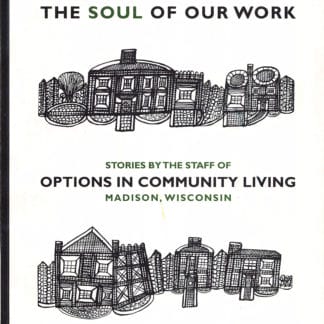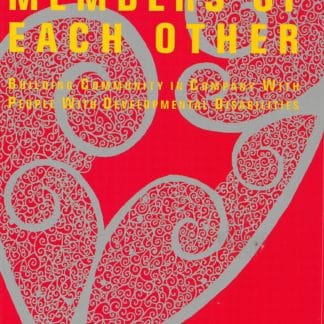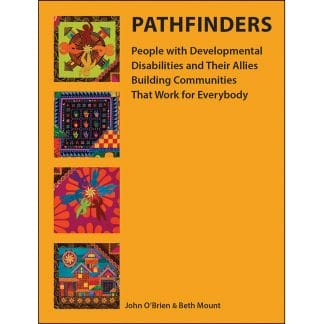
John O’Brien
A great question
refuses to be answered.
So it keeps leading us
into deeper connections
with each other and
into deeper thinking.
Judith’s engagement with the great questions she investigates in this collection was existential. From her earliest self-awareness untilgoing to bed late on the night she died she never knew herself apart from the need for personal assistance with the most basic of life’s tasks. Her survival depended on her gift of drawing people into deeper connections and deeper thinking –a gift so strong in her as to precipitate her circle of support at a time when she herself was exhausted to the point of hopeless silence. Always her quality of life depended on the openness of the people who attended her.
It is essential that the attendant willingly give their mind and their body to the person
being assisted so the person can tell the attendant what it is they want to do,
how they want to do it, and thus live and work through the body of the assistant.
If the attendant is unavailable, then the relationship doesn’t work.
It just falls apart and becomes abusive for both people.*
* From Behind the Piano, p. 111.
As Judith established relationships with teachers like Peter (see page 41), whose gifts many people overlooked because of the attention and imagination required to understand his communication, her understanding of the integral relationship between the gifts of outsiders and the strength of community came into focus. Peter’s gifts had affect because of his identity and presence in a social setting that discovered its receptiveness to him. As Judith saw it, this was a matter of relationship, not a deliberate effort to help him or remedy a deficiency in him. It’s power does not even depend on explicit recognition of his gift or conscious effort to include, though recognition and reflection are the foundation of Judith’s learning from Peter.
Through the 1980’s, alliance with children excluded from school and parents and educators struggling for schools where all are welcome and each belongs opened the question of how to create positive relationships that bridge difference in ways that benefit everyone. Willing school and classroom leaders –both adults and students– could act with purpose to cultivate belonging and mutual support. (These arts have since too often drowned in the sea of organizational anxiety over test scores.)
The struggle for inclusion influences everyone’s capacity to draw others into deeper connections and deeper thinking to respond to the great questions in their own life. What is my life’s highest purpose? How do I serve my community and its diverse members? How does my love and desire find expression? How do I cope gracefully with fallibility and failure in myself and others? Judith was extraordinarily passionate and daring in her personal involve- ment with these questions. Her many adventures and experiments in living gave color and credibility to her advice and teaching.
The frame for addressing great questions involving people likely to be excluded became clear to Judith soon after she established the friendships and self-directed system of personal assistance that supported her in pursuit of a full life. Communities flourish when they welcome the gifts of those who have been outsiders. Gifts are revealed by listening deeply to dreaming and identifying seeds for contribution. The cultivation of those seeds is the work of a committed circle of support who overcome obstacles by living the conviction that together we’re better. People have the right to a secure home of their own and reliable ways to get where they want to go –including across oceans. Some people will require adaptive technology, accommodation or personal assistance to bring their gifts to their community. Such assistance, and the public funds to pay for it, should be under the direct control of the person or those who know and love them.
Judith never stopped sharing her well reasoned conviction that gift- ed listening encourages dreaming and dreaming reveals gifts whose continual exchange create inclusion and strengthen community. Throughout her life as a teacher and advisor she wrestled with the great question of how to understand and respond to disability as a social category.*
Judith was convinced that gifts easily rejected were essential to a thriving community. Her recognition of the burden of bringing these gifts to a culture disposed to overlook, inhibit or destroy them led her to compose a story that a mother might tell her child as an orientation to being a gift-bearer in an alien culture (page 35).
* I am writing about this because, as far as I know, Judith spoke but did not write about her best developed understanding of this question. What is here is based on personal conversation (sometimes in the form of intense arguments, as was our frequent conversational habit) and from listening to her speak.
Judith knew, almost at the cost of her life, the negative cultural power that the social and political category of disability has to obscure attention to giftedness. Pursuing a life outside the bound- aries prescribed for a nursing home patient brought malnutrition and abuse inside the facility and deprivation and unbearable strain when she escaped alone.
Under the category of disability, I am a lack, a problem that is supposed to be fixed if possible,
hidden if I can’t be fixed and, at the very least, considered something that shouldn’t
have happened. Those of us who have been labeled tend to go through life
as if people do not see us because they are looking over our shoulder at somebody
they think we should have been. Someone looks at me and sees the person
that doesn’t use a wheelchair, the person they think I would have
been if I didn’t have spinal muscular atrophy. Because to see me as I am
is somehow not right, not bearable. The culture constantly is telling me,
“This kind of body is right and your kind of body is not.” So even though
I know myself as a whole person, I still daily experience the sense that
this is not the right way to be.*
The disability category draws people into limiting relationships.
Many people, especially parents of a newly labeled child, establish their relationship
with a person who is disabled through a process of identifying a need the person
is struggling with or through empathizing with an experience of injustice that the
person is undergoing. Taking on the role of therapist and advocate,
one person stands by the other.
Therapy calls for the person with a handicap to be seen as needing to be fixed
in some way. Advocacy calls for the person with a handicap to be viewed
as a victim of some outrageous misfortune or circumstance. Both these stances
have value and can lead to good for the person and the community.
But neither approach calls for a contribution from the labeled person
in order to sustain the relationship or the work. And if success in therapy or
advocacy is not quickly forthcoming the relationship must suffer.
Paradoxically even success can destroy such a relationship
because success erodes its foundation.*
* Unless otherwise attributed, the quotations in this chapter are para- phrased from the video It’s About Grace.
The disability category not only contaminates perception and limits relationships, it distorts public policy in a way that people who need public funded support cannot avoid because it goes unques- tioned. Without a willingness to advocate from conviction that individual control of adequate public funding for individualized assistance is a matter of human rights, bureaucratic blunders will rob Judith of the assistance she needs to live, as from time to time they did. But it was clear to her that advocacy, necessary as it is, competes for attention with relationships that allow giftedness to flourish.
Judith experimented with different approaches to the disability category. She challenged herself to find alternative language that allowed accurate descriptions without resort to language based in the disability category.** She provocatively challenged audienceswith the argument that There is no such thing as disability.
* The Power in Vulnerability, page 32.
** You can read an extended example of this experiment in Judith’s autobiography, Who’s Drawing the Lines
This last attempt at exorcism didn’t really work. It wasn’t true to her experience: maintaining her own supports intermittently engaged her own considerable advocacy skills to make financing for personal assistance that is structured by disability category work for her. Many of those she advised benefited from assistants highly skilled in responding to their impairments with knowledge gained in pro- fessional study. And most audiences had trouble grasping her point in a productive way.
Her struggle with the disability category was fruitful. Attending to the positive effects of relationships with people whose lives could be swallowed whole by the disability category* clarified her under- standing of the duality that the culture creates with the disability category and the choice it frames.
Disability is an expression of a world of categorization along with race, class
and other distinctions that divide us. Within the category of disability I have
certain rights and privileges. But inside that kind if thinking I m not able to
move very far out of my space and my space does not allow me to express
my deep personal giftedness, or my deep personal relationship with life itself…
I live in a world that’s about categories and structures. A world in which
the category of disability is powerful in my life. I am also in a a personal
relationship with the Creator of the universe. Both are true.
I am both disabled and not disabled at the same time.
The question is, from which stance can I live my life most power fully
both for myself and for the community. From which position am I more able
to contribute? More able to experience a fulfilled life? More able to bring
richness as a legacy beyond when I will personally be present in the world?
I don’t think disability is the position from which I can be powerful.
I think disability is the position from which I can be controlled.
* See Gifts on page 39.
This both/and understanding sharpened her teaching about inclusion and led her to articulate the BMX Model of inclusion (page 107, page 111). The X (Crossover) stage of the BMX model is a formal statement of this deeper insight.
The point of inclusion is not to help people who would otherwise
be excluded. The point is that when we live separately we all cut
ourselves off from the power of joining people’s different kinds of relationships
and experiences. Separation simply limits our experience of life. Inclusion
brings us a much richer community. To be inclusive means to open up a dialogue.
This is not a discussion about “How can I help you?” It is not an intellectual exercise.
It is a dialogue in action for all those involved to discover what the others bring
that has not been seen before, what the others makes available that
has not been possible before.

The question is, from which stance can I live my life most powerfully both for myself & for the community. From which position am I more able to contribute? More able to experience a fulfilled life? More able to bring richness as a legacy beyond when I will personally be present in the world?



